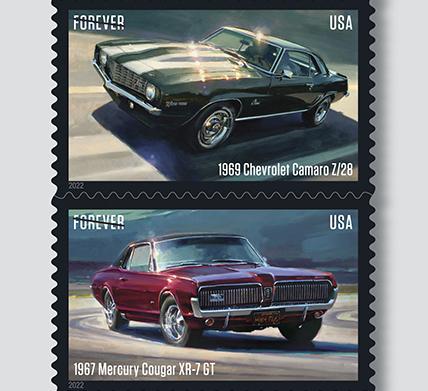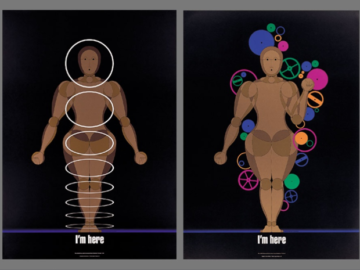The Journey Group has a tale of passion meeting profession while riding the highway of creativity. Knowing the roar of engines from his childhood days, Zack Bryant had the chance to bring his love for cars to life through his stamp design work with the United States Postal Service. The studio captured the spirit of the iconic “Pony Cars” through the brush of artist Tom Fritz. These stamps, a testament to the legendary automotive beasts like the Ford Mustang, Camaro, and more, served as an ode to the American automobile journey that Bryant reveled in as a young boy. Fasten your seatbelts as we steer through the fast lane of design, nostalgia, and the revving heart of American automotive history.
By: Zack Bryant

For a designer who grew up playing with Hot Wheels as a kid, creating car stamps for the Postal Service was a dream come true. If you don’t know, the term “pony cars” is derived from the best-known of the bunch: the Ford Mustang. In the mid-1960s, the big American automakers began designing performance cars that—for the first time—could be attainable to average working families. This democratization of speed led to some of the most iconic vehicles ever produced: the Camaro, Challenger, Cougar, Javelin, and, of course, the Mustang. You don’t have to be a car enthusiast to know these names—they’re the stuff of legend.
I grew up in Richmond, Virginia, and even as a kid, I knew every dad in the neighborhood who had one of these beauties in their garage. On sunny Saturdays during the summer, they’d be ceremoniously rolled out onto the driveway for a wash and wax. The other kids and I would ride our bikes over to cheer when the key was turned and they roared to life—emerging from the dark cavern of the garage like some beast finally released from its cage. For the past sixteen years, I’ve worked in a design studio at Journey Group, based in nearby Charlottesville. Our founding partner, Greg Breeding, is an art director for the USPS, and, knowing my passion for internal combustion, he invited me to collaborate on the Pony Cars stamps when the assignment was made.
In response to the design brief, I started researching the origin, reactions to, and contemporary collecting culture around these iconic cars. It was also important to know the shoulders on which we stood. The Pony Cars were to be the latest in the tradition of stamps celebrating American cars, including 50s Sporty Cars in 2005 and 50s Fins and Chrome in 2008. The art for both of these celebrations of ‘50s car culture was created by the late Art Fitzpatrick.
More recently, back in 2013, the Postal Service released an issuance called Muscle Cars that showcased five high-performance cars from the late ‘60s and 1970s. I remember being struck by the dynamism and atmosphere in the paintings at the time and we quickly had the idea of reconnecting with the artist who’d created the Muscle Cars stamps. His name is Tom Fritz, from Newbury Park, California. Selecting him as a collaborator was the single greatest contributor to the success of the project.
Because our Pony Cars come from the same era and share much of the same design DNA and nostalgia, our initial direction to Tom was to try to create five new works that would live happily alongside the existing Muscle Cars stamps from the previous decade. Tom was instrumental in selecting which five cars to show—a contentious subject, I assure you! (I still occasionally hear from jilted lovers of the Pontiac Firebird.)
Once we’d chosen our five cars, seeking to represent the major players and reacquaint a new generation with lesser-known cars like the Javelin, we set about choosing the trim packages and colors that would work best in a set of five. Tom and I combed through online forums, vintage dealer brochures, and even some beautiful old factory paint swatch books and graphics manuals. It was critical to get every last detail—from the lightbulb placement to the type of tires—exactly right.
Tom Fritz is an absolute master of his craft, and moved deftly through sketches, choosing angles and lighting that would let each individual pony show off. The art director, Greg Breeding, is an equivalent master of designing postage stamps and even in the sketching stage, we began exploring how the stamps would work together when assembled in a pane. We had the idea to set the Pony Cars on a seamless black background, creating some contrast with the white background of the Muscle Cars. I love the way the black frames each individual stamp on a light-colored envelope but unifies them when they’re together on a pane.
We explored more vernacular typographic ideas that referenced the sort of type you’d see on cars and marketing materials in the late sixties but ultimately decided that a minimal condensed sans-serif was most appropriate for the subject and would let Tom’s artwork shine. Throughout the process, the team at USPS provided helpful critiques and feedback on our work. Once the final paintings were scanned and placed into the stamp file, the iteration really paid off. In particular, the way Tom’s brushwork—light, dust, blur, and physicality—scaled down to stamp size is absolutely stunning.
I had the privilege of attending the ceremony where the stamps were first made available at the Great American Stamp Show in Sacramento, California. For me, getting to hear from folks as passionate about stamps as they are about cars was a great thrill. And it was even more rewarding to hear Tom Fritz speak about his process and to see him honored for his beautiful contribution to the catalog of American stamps. We heard countless stories about the nostalgia these cars evoke—of fathers and friends, of newfound freedoms, of first loves, and of passing something great to the next generation.
Flying back home from Sacramento, I was reminded that it’s not really about the cars or the stamps at all. Decorating our postage is just one small opportunity to honor one another in this particular time and place. And my hope is that our society continues to find ways to point out the good in one another. When we use art and ceremony to commemorate the best of us—and when we take time to hear the stories of those for whom these memories matter most—we help ensure deep roots for the seasons to come.
Zack Bryant was strongly influenced by street art and the music scene while growing up in Richmond, Virginia, where he played in bands and designed show posters and album art. He attended James Madison University’s College of Arts and Letters, studying abroad in Eastern Europe and graduating in 2004 with a focus on graphic design. After teaching and freelancing, he joined Journey Group in Charlottesville, Virginia, where he serves as a principal. Bryant also manages a small regenerative farm just outside Charlottesville. Bryant’s design projects for the U.S. Postal Service include Heritage Breeds (2021) and Pony Cars (2022).






